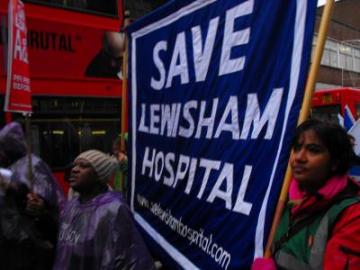The demonstration on Saturday 24th November against the closure of A&E and Maternity wards at Lewisham Hospital drew a huge turnout of between 10,000 and 15,000 people yesterday.
Seasoned older marchers agreed it was the biggest demo in the borough since the New Cross Fire of 1981 or Lewisham’s 1977 mobilisation against the National Front.
The numbers, in pouring rain and on the same day as a demo against the ongoing atrocities in Gaza, showed massive popular feeling and determination to fight the closure.
The crowd was very local and very diverse, all the different populations of Lewisham from the local pensioners forum to small woolly-hatted girls holding placards saying “I could have died by the time the ambulance reached Woolwich” walking alongside huge numbers of NHS workers.
If the closures go ahead it would mean just one A&E would be left serving a population of 750,000 people, — a punishment for being the “wrong” type of population.
Previous calculations about distribution of NHS resources included the poverty of the area as it is linked to health needs in so many ways — infant mortality, accidents, infectious diseases such as tuberculosis.
Now the government has removed this requirement from its analysis and so Lewisham is not seen to need so many services — or possibly contains too many of the wrong sort, who shouldn’t be encouraged to breed or recover from accidents.
The demo showed how strongly the local community feels about this particularly brutal cut inflicted by the austerity programme. However our problem now is, how do we actually stop the closure?
The government knows the NHS is hugely popular. They are getting rid of it anyway. They don’t care if the people on the demo bleed to death in ambulances stuck in traffic on the way to Woolwich, so they probably aren’t frightened of their opinions.
To stop the closure we will need a similarly huge direct action mobilisation, and years of atomisation mean this will be very difficult. This is the position so much of the working class is in now — there is some will to fight, but the attacks on us are coming so thick and fast, and we are not prepared or mobilised.
However the size of the demo shows that healthcare is probably one of the areas of austerity where people feel the strongest, and where there is a memory of resistance in the hospital occupations of the early ’90s.
Fri, 30/11/2012 - 19:40
Community turns out en masse for Lewisham Hospital demo
Recent articles
This article was published on 30 November 2012 by the SolFed group in South London. Other recent articles:
Other Posts
| Ledbury Estate tenants march calling for urgent repairs, next demo Sunday 24th September (posted 21. September) |
| Multiple Chemical Sensitivity (posted 19. February) |
| Call for Soldarity for the Woolwich Free Ferry Strikes (posted 3. February) |
| Direct Action Discussion at Solfed Conference (posted 8. December) |
| Byron Greenwich Picket (posted 31. July) |
